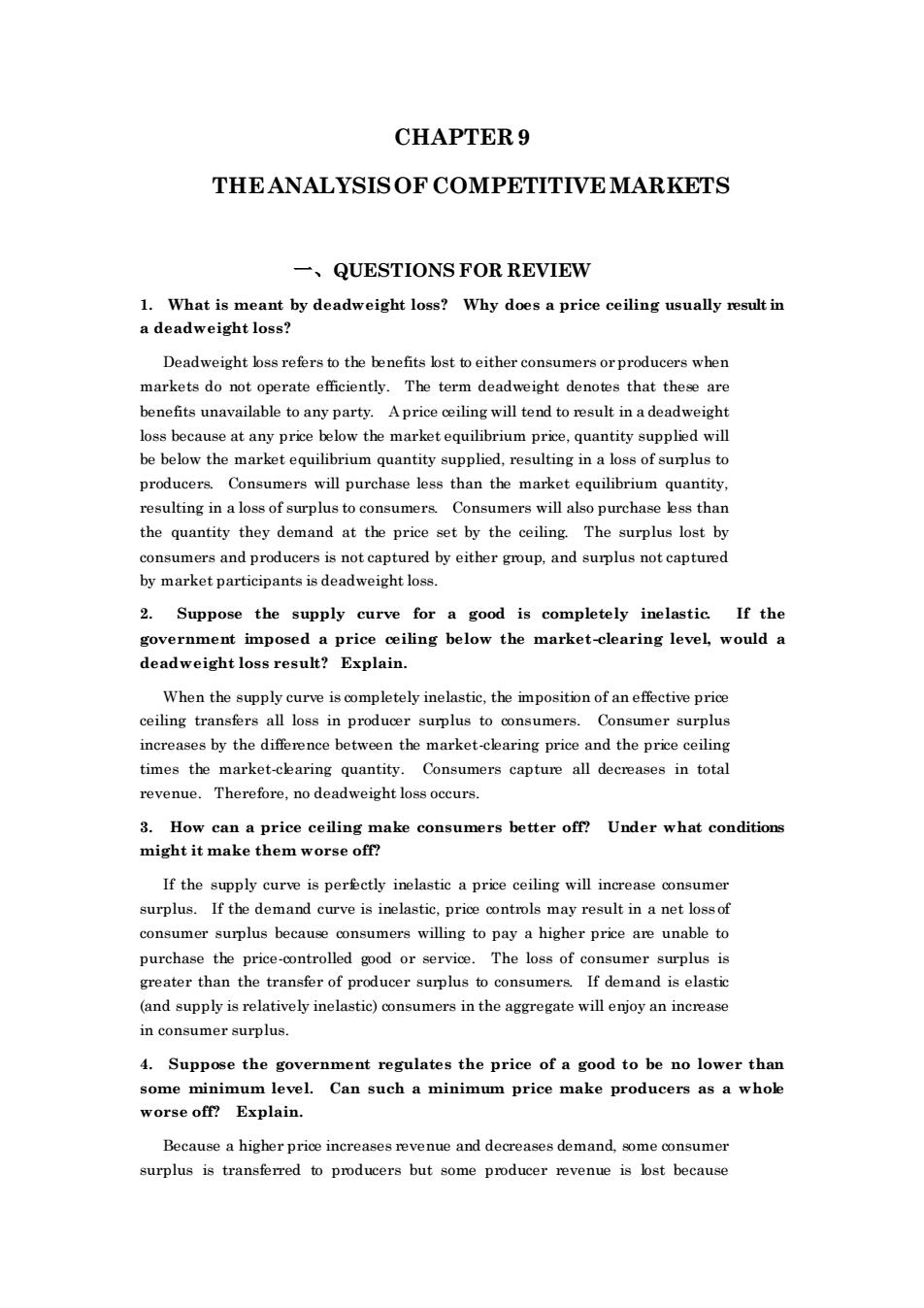正在加载图片...

CHAPTER9 THEANALYSISOF COMPETITIVEMARKETS -QUESTIONS FOR REVIEW 1.What is meant by deadweight loss?Why does a price ceiling usually result in a deadweight loss? Deadweight oss refers to the benefits bst toeither consumers orproducers wher markets do not operate efficiently.The term deadweight denotes that these are benefits unavailable to any party.Aprice ceiling will tend to result in a deadweight loss because at any price below the market equilibrium price.quantity supplied will be below the market equilibrium quantity supplied,resulting in a loss of surplus to producers、Consume will pure s than the market equilibrium quantity resulting in a loss of surplus to consumers Consumers will also purchase less thar the quantity they demand at the price set by the ceiling.The surplus lost by consumers and producers is not captured by either gmoup,and surplus not captured by market participants is deadweight loss. 2.Suppose the supply curve for a good is completely inelastic.If the mposed price ilin below the market-clearing a deadweight loss result?Explain. When the supply curve is completely inelastic,the imposition of an effective price ceiling transfers all loss in producer surplus to consumers.Consumer surplus increases by the difference between the market-clearing price and the price ceiling times the market-clearing quantity.Consumers capture all decreases in total revenue.Therefore,no deadweight loss occurs 3.How can a price ceiling make consumers better off?Under what conditions might it make them worse off If the supply curve is perfectly inelastic a price ceiling will increase consume surplus.If the demand curve is inelastic,price controls may result in a net lossof consumer surplus because consumers willing to pay a higher price are unable to ourchase the price-controlled good or service.The loss of consumer su rplus is raor than th sfer of pro ducer supus to and i lastic (and supply isre tively inelastic)conumers in the aggregate will enjoy an inceas in consumer surplus. 4.Suppose the government regulates the price of a good to be no lower than some minimum level.Can such a minimum price make producers as a whole worse off?Explain Because a higher price increases revenue and decreases demand.some consumer surplus is transferred to producers but some producer revenue is lost because CHAPTER 9 THE ANALYSIS OF COMPETITIVE MARKETS 一、QUESTIONS FOR REVIEW 1. What is meant by deadweight loss? Why does a price ceiling usually result in a deadweight loss? Deadweight loss refers to the benefits lost to either consumers or producers when markets do not operate efficiently. The term deadweight denotes that these are benefits unavailable to any party. A price ceiling will tend to result in a deadweight loss because at any price below the market equilibrium price, quantity supplied will be below the market equilibrium quantity supplied, resulting in a loss of surplus to producers. Consumers will purchase less than the market equilibrium quantity, resulting in a loss of surplus to consumers. Consumers will also purchase less than the quantity they demand at the price set by the ceiling. The surplus lost by consumers and producers is not captured by either group, and surplus not captured by market participants is deadweight loss. 2. Suppose the supply curve for a good is completely inelastic. If the government imposed a price ceiling below the market -clearing level, would a deadweight loss result? Explain. When the supply curve is completely inelastic, the imposition of an effective price ceiling transfers all loss in producer surplus to consumers. Consumer surplus increases by the difference between the market-clearing price and the price ceiling times the market-clearing quantity. Consumers capture all decreases in total revenue. Therefore, no deadweight loss occurs. 3. How can a price ceiling make consumers better off? Under what conditions might it make them worse off? If the supply curve is perfectly inelastic a price ceiling will increase consumer surplus. If the demand curve is inelastic, price controls may result in a net loss of consumer surplus because consumers willing to pay a higher price are unable to purchase the price-controlled good or service. The loss of consumer surplus is greater than the transfer of producer surplus to consumers. If demand is elastic (and supply is relatively inelastic) consumers in the aggregate will enjoy an increase in consumer surplus. 4. Suppose the government regulates the price of a good to be no lower than some minimum level. Can such a minimum price make producers as a whole worse off? Explain. Because a higher price increases revenue and decreases demand, some consumer surplus is transferred to producers but some producer revenue is lost because